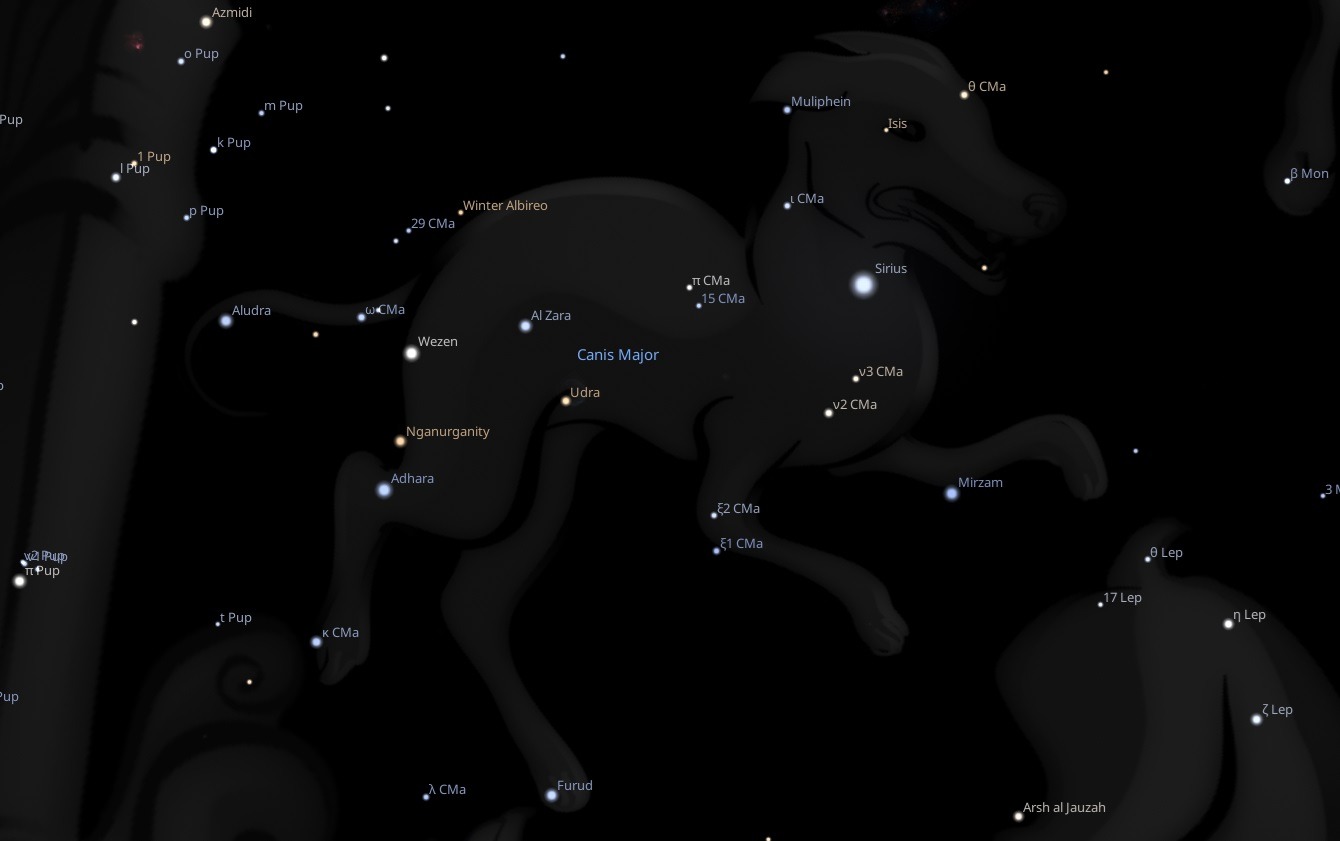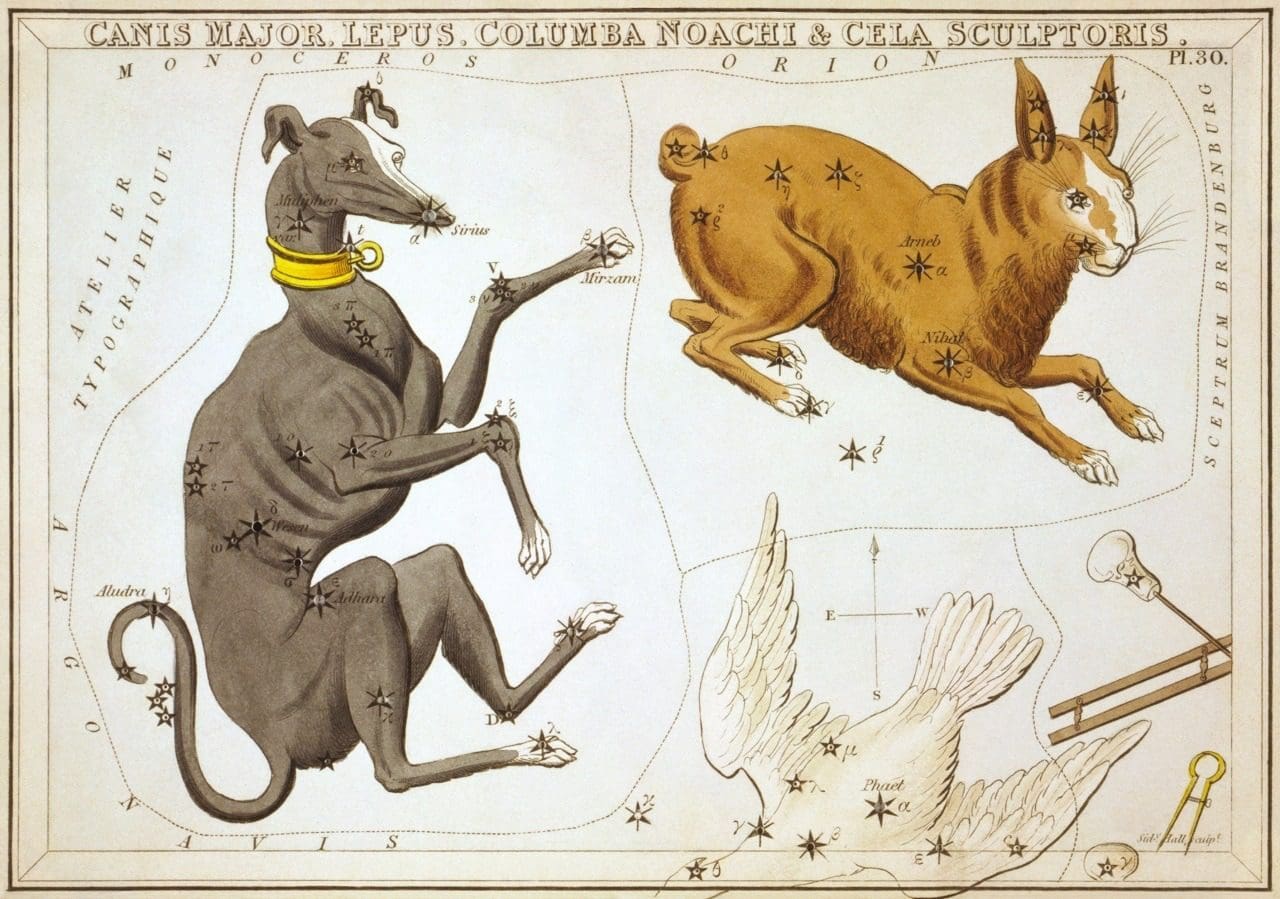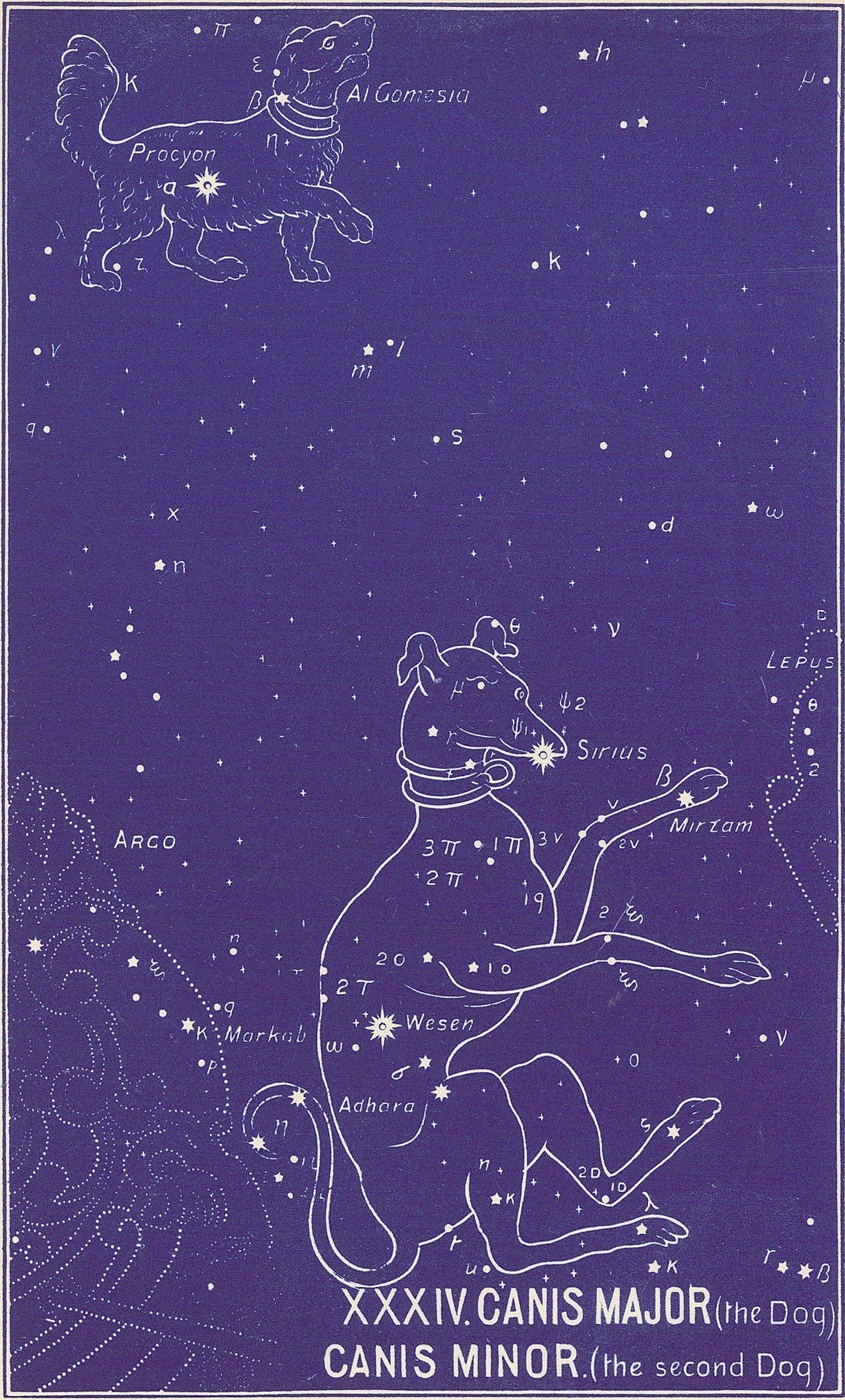FIXED STARS: Major Stars | 1000+ Stars | Constellations | About
Constellation Canis Major, the Greater Dog, is a southern constellation bordering Monoceros, Lepus, Columba, Puppis and the obsolete constellations Argo Navis and Officina Typographica.Canis Major is one of the 48 constellations listed by Ptolemy in the 2nd century and remains one of the 88 modern constellations. It spans over 20 degrees of the zodiac in the Sign of Cancer.
Abbreviation: CMa
Genitive: Canis Majoris
Canis Major Constellation Stars
| 2000 | 2050 | Star | Name | Sp. Class | Mag. | Orb |
|---|---|---|---|---|---|---|
| 07♋12 | 07♋54 | β CMa | Mirzam | B1 | 1.98 | 2°20′ |
| 07♋23 | 08♋05 | ζ CMa | Furud | B2 | 3.02 | 1°50′ |
| 10♋39 | 11♋22 | ξ1 CMa | B1 | 4.34 | 1°10′ | |
| 11♋45 | 12♋27 | ν2 CMa | Yějī | K1 | 3.95 | 1°30′ |
| 14♋05 | 14♋47 | α CMa | Sirius | A0 | −1.46 | 2°40′ |
| 16♋11 | 16♋53 | θ CMa | K4 | 4.08 | 1°20′ | |
| 17♋03 | 17♋45 | μ CMa | Isis | B9 | 5.00 | 1°00′ |
| 17♋32 | 18♋14 | ι CMa | B3 | 4.36 | 1°10′ | |
| 18♋10 | 18♋52 | ο1 CMa | Udra | K3 | 3.89 | 1°30′ |
| 18♋35 | 19♋16 | κ CMa | B1 | 3.50 | 1°40′ | |
| 19♋37 | 20♋19 | γ CMa | Muliphein | B8 | 4.12 | 1°20′ |
| 20♋46 | 21♋28 | ε CMa | Adhara | B2 | 1.50 | 2°20′ |
| 21♋01 | 21♋43 | ο2 CMa | Al Zara | B3 | 3.02 | 1°50′ |
| 21♋34 | 22♋16 | σ CMa | Nganurganity | K4 | 3.49 | 1°40′ |
| 23♋24 | 24♋06 | δ CMa | Wezen | F8 | 1.83 | 2°20′ |
| 25♋16 | 25♋58 | 145 CMa | Winter Albireo | K4 | 4.83 | 1°00′ |
| 25♋38 | 26♋20 | ω CMa | B2 | 4.01 | 1°20′ | |
| 26♋23 | 27♋05 | τ CMa | O9 | 4.37 | 1°10′ | |
| 29♋33 | 00♌15 | η CMa | Aludra | B5 | 2.45 | 2°10′ |
Canis Major Astrology
Manilius (@35 AD)
Next barks the Dog, and from his Nature flow
The most afflicting Powers that rule below,
Heat burns his Rise, Frost chills his setting Beams,
And vex the World with opposite Extremes.
He keeps his Course, nor from the Sun retreats,
Now bringing Frost, and now encreasing Heats:
Those that from Taurus view this rising Star,
Guess thence the following state of Peace and War,
Health, Plagues, a fruitfull or a barren Year.
He makes shrill Trumpets sound, and frightens Peace,
Then calms and binds up Iron War in Ease.
As he determines, so the Causes drawn,
His Aspect is the World’s supremest Law.
This Power proceeds from the vast Orb He runs,
His Brightness equals or exceeds the Sun’s.
•ut far remov’d he through the distant space
•arts feeble splendour from his Azure face.
Yet others He excells, no fairer Light
Ascends the Skies, none sets so clear a bright. [Astronomica, Manilius, 1st century AD, Book 1, pp. 17-18. (Creech, 1700).]
It is Orion who leads the constellations as they speed over the full circuit of the heavens. At his heels follows the Dog outstretched in full career: no star comes on mankind more violently or causes more trouble when it departs. Now it rises shivering with cold, now it leaves a radiant world open to the heat of the Sun: thus it moves the world to either extreme and brings opposite effects. Those who from Mount Taurus’ lofty peak observe it ascending when it returns at its first rising learn of the various outcomes of harvests and seasons, what state of health lies in store, and what measure of harmony. It stirs up war and restores peace, and returning in different guise affects the world with the glance it gives it and governs with its mien. Sure proof that the star has this power are its colour and the quivering of the fire that sparkles in its face. Hardly is it inferior to the Sun, save that its abode is far away and the beams it launches from its sea-blue face are cold. In splendour it surpasses all other constellations, and no brighter star is bathd in ocean or returns to heaven from the waves. [1]
Robson
Legend. This constellation is said to represent the dog set by Jupiter to guard Europa whom he had stolen and conveyed to Crete. According to other accounts, however, it was either Laelaps, the hound of Actaeon; that of Diana’s nymph Procris; that given by Aurora to Cephalus; or finally one of the dogs of Orion.
Influence. Ptolemy states that the stars of this constellation, with the exception of Sirius, are like Venus (if rising, good fortune, happiness, gifts, fortunate for love and marriage, gain by legacies and inheritance. If culminating, honor and success, dealings with and help through women, success in occupations of a Venus nature). It is said to give good qualities, charity and a faithful heart, but violent and dangerous passions. There is some danger from, or fear of, darkness and the night, and liability to dog bites, though the latter characteristic is probably associated more particularly with Sirius. Canis Major is connected by the Kabalists with the Hebrew letter Tzaddi and the 18th Tarot Trump, “The Moon”.
Magical. Cures dropsy, resists plague, and preserves from beasts. [2]
Allen
Canis Major, the Greater Dog of the southern-heavens, and thus Canis Australior, lies immediately to the southeast of Orion, cut through its centre by the Tropic of Capricorn, and with its eastern edge on the Milky Way… The Latins adopted their Canis from the Greeks, and it has since always borne this name, sometimes even Canicula in the diminutive (with the adjectival candens, shining), Erigonaeus (from Virgo), and Icarius (from Bootes); the last two being from the fable of the dog Maera, — which itself means Shining, — transported here; her mistress Erigone having been transformed into Virgo, and her master Icarius into Bootes. Ovid alluded to this in his Icarii stella proterva canis; and Statius mentioned the Icarium astrum, although Hyginus had ascribed this to the Lesser Dog (Canis Minor). [3]
Bullinger
This second constellation carries on the teaching, and tells of the glorious Prince who will thus subdue and reign. In the Denderah Zodiac he is called Apes, which means the head. He is pictured as a hawk (Naz, caused to come forth, coming swiftly down). The hawk is the natural enemy of the serpent, and there it has on its head a pestle and mortar, indicating the fact that he shall crush the head of the enemy. In the Persian planisphere it is pictured as a wolf, and is called Zeeb, which in Hebrew has the same meaning. Plutarch translates it Leader. In Arabic it means coming quickly.
Its ancient name and meaning must be obtained from the names of its stars which have come down to us. There are 64 altogether. Two are of the 1st magnitude, two of the 2nd, four of the 3rd, four of the 4th, etc. Of these α (in the head) is the brightest in the whole heavens! It is called Sirius, the Prince as in Isaiah 9:6. Sirius (our English “Sir” is derived from this word) was, by the ancients, always associated with great heat. It is not, however, of its heat that its name speaks, but of the fact that it is the brightest of all the stars, as He of whom it witnesses is the “Prince of princes,” “the Prince of the Kings of the earth.”
Though this “Dog-Star” came to have an ill-omened association, it was not so in more ancient times. In the ancient Akkadian it is called Kasista, which means the Leader and Prince of the heavenly host. While (as Mr. Robert Brown, Jr, points out) “the Sacred Books of Persia contain many praises for the star Tistrya or Tistar (Sirius), ‘the chieftain of the East.'” (Euphratean Stellar Researches)
The next star, β (in the left fore foot), speaks the same truth. It is named Mirzam, and means the prince or ruler. The star δ (in the body) is called Wesen, the bright, the shining. The star ε (in the right hind leg) is called Adhara, the glorious.
Other stars, not identified, bear their witness to the same fact. Their names are–Aschere (Hebrew), who shall come; Al Shira Al Jemeniya (Arabic), the Prince or chief of the right hand! Seir (Egyptian), the Prince; Abur (Hebrew), the mighty; Al Habor (Arabic), the mighty; Muliphen (Arabic), the leader, the chief. [4]
References
- Astronomica, Manilius, 1st century AD, book 1, p.34-37. (Goold, 1977).
- Fixed Stars and Constellations in Astrology, Vivian E. Robson, 1923, p.34, 231.
- Star Names: Their Lore and Meaning, Richard H. Allen, 1889, p.131-135.
- The Witness of the Stars, E. W. Bullinger, 1893, CANIS MAJOR (the Dog).


